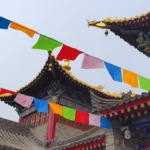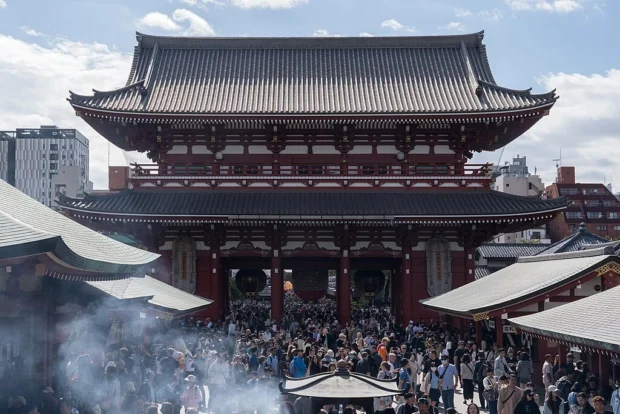If you want to visit a famous place in Tokyo, Japan, Senso-ji Temple is a great choice. It stands in Asakusa, a lively area full of culture and old traditions. This temple is one of the oldest and most important temples in Tokyo. Many people come here to see its big red gate, peaceful gardens, and busy markets. Near Senso-ji, you will find many places to stay, local restaurants serving tasty Japanese food, especially tempura and sweets, and easy transport options from the city center or airport.
Table of Contents
Getting to Senso-ji Temple Made Easy
Traveling to Senso-ji Temple is simple. If you are coming from Tokyo Station, take the JR Yamanote Line or Tokyo Metro Ginza Line to Asakusa Station. From Narita Airport, you can catch the Narita Express train or the Keisei Skyliner to access Asakusa directly. The temple is a short walk from Asakusa Station, well marked and easy to follow.
Many visitors like to arrive early in the morning or later in the afternoon to avoid the biggest crowds. Weekdays are quieter than weekends, giving a better chance to enjoy the temple’s calm atmosphere.
The Story Behind Senso-ji Temple
Senso-ji Temple has a legend many people find interesting. Long ago, in the year 628, two fishermen found a small statue of Kannon-the goddess of mercy-in the Sumida River. Even though they put it back into the water, it kept coming back to them. A local leader heard about this and decided to build a temple to honor Kannon. Since then, Senso-ji has been a place for people to pray for safety, happiness, and health.
This temple survived many difficult times, including wars and natural disasters. It was rebuilt and maintained by the people of Tokyo with great care. Today, it stands not only as a religious place but also as a symbol of hope and endurance.
Walking Through the Iconic Kaminarimon Gate
One of the most famous sights at Senso-ji is the Kaminarimon, or “Thunder Gate.” The large, red gate welcomes visitors with a giant paper lantern that weighs almost 700 kilograms. Many visitors pause here to take photos and admire the intricate details. This gate has been the temple’s entrance for over 1,000 years, though it was rebuilt several times due to fires and storms.
Strolling on Nakamise Shopping Street
Right after passing the Kaminarimon, you will enter Nakamise Street. This busy shopping lane is full of small stores selling souvenirs, snacks, and handmade crafts. It is one of the oldest shopping streets in Japan, with a history of over 400 years. Visitors especially enjoy trying freshly made rice crackers, sweet bean cakes, and traditional toys.
Walking through Nakamise is more than shopping; it is walking through time with colorful shops and smells of street food filling the air.
To continue experiencing Japan’s rich history and spiritual sites, consider visiting Fushimi Inari Shrine in Kyoto, famous for its stunning red gates and peaceful mountain trails.
Visitor Tips for a Great Senso-ji Visit
- Best Time to Visit: Early morning or late afternoon on weekdays helps you avoid crowds and enjoy a peaceful visit.
- When to Come: Many come during special festivals like Sanja Matsuri in May, but expect large crowds then.
- Entry: No reservation or ticket is needed to enter Senso-ji Temple or Nakamise Street; it is free and open to all.
- Respectful Behavior: As a sacred place, wearing modest clothes and speaking softly is appreciated.
The Beautiful Temple Grounds Beyond the Main Hall
Beyond the busy shopping street and main hall, Senso-ji has calm gardens and smaller shrines. Here, you can enjoy nature and quiet spots to reflect. There is also a famous incense burner where visitors wave smoke over their heads to bring good health. A short walk leads you to the Asakusa Shrine, built beside Senso-ji in honor of the temple’s founders. Many visitors overlook these areas, but they add to the full experience.
A Peek Into Religious Traditions
Inside the temple, visitors can join traditional activities such as drawing fortune sticks (omikuji) and cleansing hands at the purification fountain. These customs connect you to the spiritual life of the temple and centuries-old practices.
More to See and Do Near Senso-ji
Asakusa offers much more than the temple itself. After a visit to Senso-ji, you can explore local food markets, try some street food, or take a boat ride on the nearby Sumida River. The area mixes old Japan with exciting modern culture in a way few other places do.
Near the temple, you will find many guesthouses and inns where visitors can stay comfortably and enjoy easy access to Senso-ji and the wider Tokyo area. This makes it a perfect base for a longer visit.
Official Senso-ji Website and Visitor Information
For detailed information about Senso-ji Temple, upcoming events, and travel advice, visit the official [Senso-ji Temple website](http://www.senso-ji.jp/). This site provides useful guides in English and Japanese to help plan your visit and understand the temple’s history deeply.

A Chinese tour guide with deep knowledge of the Far East, its traditions, and culinary secrets.
- 2024-10-20 Tokyo, Sensō-ji 1 by Alexkom000 on Wikimedia Commons – cc by 4.0
